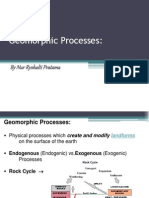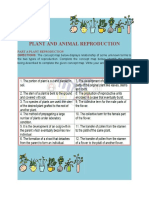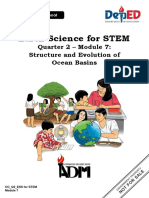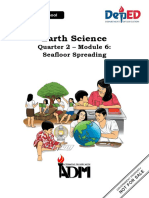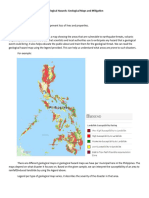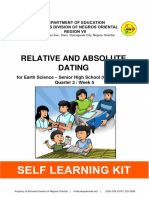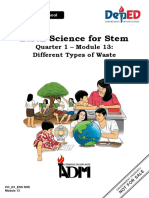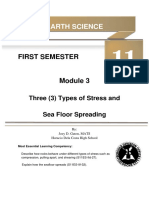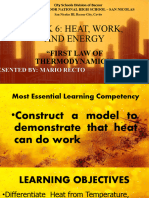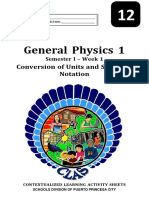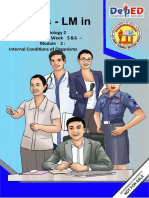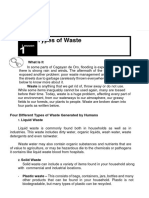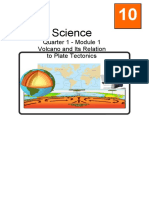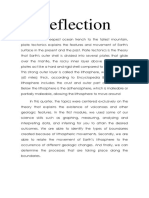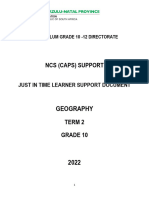Earth Science: Quarter 2 - Module 5 Rock Behaviors Under Stress
Uploaded by
Isha GishEarth Science: Quarter 2 - Module 5 Rock Behaviors Under Stress
Uploaded by
Isha GishEarth science
Quarter 2 –Module 5
Rock Behaviors Under Stress
CO_Q2_Earth Science (SHS)_ Module 5
Earth Science
Alternative Delivery Mode
Quarter 2 – Module 5 – Rock Behaviors Under Stress
First Edition, 2020
Republic Act 8293, section 176 states that: No copyright shall subsist in
any work of the Government of the Philippines. However, prior approval of the
government agency or office wherein the work is created shall be necessary for
exploitation of such work for profit. Such agency or office may, among other things,
impose as a condition the payment of royalties.
Borrowed materials (i.e., songs, stories, poems, pictures, photos, brand
names, trademarks, etc.) included in this module are owned by their respective
copyright holders. Every effort has been exerted to locate and seek permission to use
these materials from their respective copyright owners. The publisher and authors
do not represent nor claim ownership over them.
Published by the Department of Education
Secretary: Leonor Magtolis Briones
Undersecretary: Diosdado M. San Antonio
Development Team of the Module
Writers: Rowena A. Lambongog
Editors: Randie B. Atienza and Eleneth D. Escalona
Reviewers: Marionel U. Briz,Francia C. Silva, Rowena D. Cabandingan
& Job S. Zape Jr.
Illustrator: Patrick Lemuel V. Reyes
Layout Artist: Paulina S. Crescini, Leomar G. Paracha
Management Team: Wilfredo E. Cabral
Job S. Zape Jr.
Eugenio S. Adrao
Elaine T. Balaogan
Felizardo O. Bolaňos
Joephi F. Falqueza
Sacoro R. Comia
Generiego O. Javier
Rowena D. Cabanding
Printed in the Philippines by ________________________
Department of Education – RegionIV-A CALABARZON
Office Address: Gate 2 Karangalan Village, Barangay San Isidro
Cainta, Rizal 1800
Telefax: 02-8682-5773/8684-4914/8647-7487
E-mail Address: [email protected]
EARTH SCIENCE
Quarter 2 – Module 5
Rock Behaviors Under Stress
Introductory Message
This Self-Learning Module (SLM) is prepared so that you, our dear
learners, can continue your studies and learn while at home. Activities,
questions, directions, exercises, and discussions are carefully stated for you
to understand each lesson.
Each SLM is composed of different parts. Each part shall guide you
step-by-step as you discover and understand the lesson prepared for you.
Pre-tests are provided to measure your prior knowledge on lessons in
each SLM. This will tell you if you need to proceed on completing this module
or if you need to ask your facilitator or your teacher’s assistance for better
understanding of the lesson. At the end of each module, you need to answer
the post-test to self-check your learning. Answer keys are provided for each
activity and test. We trust that you will be honest in using these.
In addition to the material in the main text, Notes to the Teacher are
also provided to our facilitators and parents for strategies and reminders on
how they can best help you on your home-based learning.
Please use this module with care. Do not put unnecessary marks on
any part of this SLM. Use a separate sheet of paper in answering the exercises
and tests. And read the instructions carefully before performing each task.
If you have any questions in using this SLM or any difficulty in
answering the tasks in this module, do not hesitate to consult your teacher
or facilitator.
Thank you.
What I Need to Know
Most Essential Learning Competency:
Describe how rocks behave under different types of stress such as
compression, pulling apart, and shearing.
This module presents how rocks behave under different types of stress such
as compressing, pulling apart, and shearing. This aims to provide an overview of
three kinds of stress which causes rocks to undergo deformation. This includes pre-
test, procedure/learning experience/learning activities, reflection and posttest. Read
the directions carefully before doing all the exercises and activities.
At the end of this module, the successful learner will be able to:
1. identify the different types of stress on rocks;
2. explain the behavior of the rocks under the different types of stress; and
3. describe the different geologic structures that cause the different stress on
rocks.
What I Know
Directions: Read and analyze the following questions. Write y the letter of the correct
answer in a separate sheet of paper.
1. Mountains are a result of high-impact stress caused when two plates collided.
What kind of stress caused it to form?
A. compressional stress
B. rock stress
C. shear stress
D. tensional stress
2. What will happen to the rock if it is exposed to a tension stress?
A. Rocks will be pulled apart
B. Rocks will be compressed
C. Rocks will fold or form fracture
D. Rocks will be squeezed together
3. Which of the following type of stress is exerted in convergent plate
boundaries?
A. Compressional stress
B. Direct stress
C. Shear stress
D. Tensional stress
1
CO_Q2_Earth Science (SHS)_ Module 5
4. Ava played a clay bar. She pushed the two sides of the clay bar using equal
force from her hands on the same axis. What type of stress did she exerted on
the clay bar?
A. Compressional stress
B. Direct stress
C. Shear stress
D. Tensional stress
5. How does the clay bar behave after the application of stress in item no. 4?
A. The clay bar will lengthen.
B. The clay bar will break apart.
C. The clay bar will fold or fracture.
D. The clay bar will be pulled apart.
6. Which location does shear stress commonly occur?
A. Combine plate boundaries
B. Convergent plate boundaries
C. Divergent plate boundaries
D. Transform plate boundaries
7. What happened to the rocks under shear stress?
A. The rocks are squeezed.
B. The rocks fold or fracture.
C. The rocks are pulled apart.
D. The rock walls slip to each other on opposite direction.
8. A compressive stress was exerted on the rock layers forming a simple fold or
bend. What is the type of fold formed on the rock layers?
A. Anticline
B. Incline
C. Monocline
D. Syncline
9. What type of fold is formed when a compressive stress resulted to a landmass
that arches upward?
A. Anticline
B. Incline
C. Monocline
D. Syncline
10. What type of fault is shown on the illustration below?
A. Normal
B. Reverse
C. Strike Slip
D. Transverse
11. Which of the following type of fault is found in divergent plate boundaries?
A. Normal
B. Reverse
C. Strike Slip
D. Transverse
2
CO_Q2_Earth Science (SHS)_ Module 5
12. Which of the following type of fault system creates the world’s highest
mountain ranges?
A. Normal
B. Reverse
C. Strike Slip
D. Transverse
13. Which of the following type of fault formed the San Andreas Fault?
A. Normal
B. Reverse
C. Strike Slip
D. Transverse
14. East African Rift formed by stress on rocks that causes the hanging wall to
drop down. Which among the type of fault did it belongs?
A. Normal
B. Reverse
C. Strike Slip
D. Transverse
15. Reverse fault formed through the stress that causes the hanging wall to
moves up. Which among the following are examples of this type of fault?
A. Himalayas
B. East African Rift
C. San Andreas
D. West Valley
Lesson
Rock Behaviors Under
1 Stress
What’s In
Direction: Do you still remember metamorphism? Critical reading will help you
test how good your memory is. Read the passage below and answer the
questions that follow.
Metamorphism
Metamorphism is the process wherein heat and pressure change the rock’s
physical and chemical makeup. Chemical changes happen during metamorphism
when ions move and new minerals form. The new minerals which are the products
of chemical change become more stable in the new environment. Foliation is the
physical change that may occur during metamorphism.
3
CO_Q2_Earth Science (SHS)_ Module 5
Contact metamorphism and regional metamorphism are the two main types
of metamorphism. What are the difference between the two?
When we say contact metamorphism, it is when magma contacts a rock and
changes it by extreme heat while regional metamorphism is when great masses of
rock are exposed to pressure.
Questions
1. What is metamorphism?
2. What are the changes that occur on rocks during the process of metamorphism?
How do these changes occur?
3. Compare and contrast contact and regional metamorphism using a Venn
diagram.
What’s New
Directions: Read the statement below and reflect on the following questions. Write
your answers in a separate sheet of paper.
Have you been to Baguio City? Baguio City is considered as the Summer
Capital of the Philippines because its low temperature even during summer time.
Millions of tourists choose this place to spend their vacation due to numerous tourist
destination like Strawberry farm and Botanical garden that has variety of plants and
vegetable that thrive on temperate weather conditions. This weather condition is
possible because Baguio City is situated at the top of one of the Philippine mountain
ranges which is named as Cordillera Mountain Ranges.
Guide Questions:
1. How do Cordillera Mountain Ranges form?
2. What geologic event causes the formation of mountain ranges?
4
CO_Q2_Earth Science (SHS)_ Module 5
What is It
Rocks and large masses undergo deformation wherein it changes their shape,
location, size, tilt or break due to squeezing, shearing, or shearing. When the rocks
or plates are pulled or pushed together, stress may occur. Yes! Not only human can
experience stress, rocks also experienced different kinds of stress. In earth sciences
and geology, stress is the force per unit area that is placed on a rock. There are three
main types of stress, namely, tension, compression, and shear.
1. Tensional stress causes rocks to be pulled apart that result to lengthening
and break apart. This type of stress can be found at divergent plate
boundaries.
2. Compressional stress causes rocks to fold or fracture. It squeezes rocks
together. Compression are the most common type of stress in convergent
plate boundaries.
3. Shear stress happens when forces slide pass each other in opposite
direction which results to slippage and translation. This is the most common
stress found in transform plate boundaries.
Geologic Structures
1. Folds – are formed when rocks experienced compressive stress and
deformed plastically. It causes bending of rocks. There are three types
of folds: monoclines, anticlines and synclines. A monocline is a
simple bend in the rock layers where the oldest rocks are at the bottom
and the youngest are at the top. An anticline is a fold that arches
upward where the oldest rocks are found at the center of an anticline.
The youngest rocks are covered over them at the top of the structure.A
syncline is a fold that bends downward which rocks are curved down
to a center.
5
CO_Q2_Earth Science (SHS)_ Module 5
2. Faults - A rock under ample stress can crack, or fracture. The fracture is
called a joint because there is a block of rock left standing on either side of a
fracture line.The footwall is the rock that place on top the fault, while
thehanging wall is below the fault.
It can be classified into:
1. Normal faults–are the most common faults at divergent boundaries. In
relation to the footwall, it develops as the hanging wall drops down.East
African Rift is one of the examples of this type of fault.
2. Reverse faults – This type of faults is most common at the convergent
boundaries. It forms when the hanging wall moves up. It creates the
world’s highest mountain ranges such as Himalayas Mountains and
3. Rocky Mountains.
4. Strike slip faults–This type of faults formed when the walls move
sideways. It can be either right lateral or left lateral. It is mostly common
on transform plate boundaries. The most popular example of this type
is San Andreas Fault.
6
CO_Q2_Earth Science (SHS)_ Module 5
What’s More
A. Directions: Identify the following types of stress on the following
statements. Write T if it pertains to tensional stress, C for compressional
stress, and S for shear stress. Write your answers in a separate sheet of
paper.
__________ 1. It causes rocks to fold or fracture.
__________ 2. It causes rocks to be pulled apart.
__________ 3. The common type of stress found on divergent plate boundaries.
__________ 4. This stress on rocks result to slippage and translation of walls.
__________ 5. It occurs on convergent plate boundaries.
__________ 6. It causes rocks to lengthen and break apart.
__________ 7. This type of stress squeezes rocks together.
__________ 8. It commonly occurs in transform plate boundaries.
__________ 9. It happens when the dominant force is directed away from each other.
__________ 10. It develops when the forces are directed towards each other but not
along the same axis.
B. Directions: Complete the table below. Write your answers in a sheet of
paper.
Effects on Place Where
Type of Stress Illustration
rocks Can be Found
1. Tension
2. Compression
3. Shear
7
CO_Q2_Earth Science (SHS)_ Module 5
C. Direction: On each of the space below, unscramble the word to
give the correct term based on the given description. Write
your answers in a sheet of paper.
_______________ 1. A simple bend on the rock layers
ONESCLIMON
________________ 2. Formed when rocks experienced compressive stress and
deformed plastically
DOLF
________________ 3. A bend that arches upward
ESCLITINAN
________________ 4. A rock fracture or cracks due to stress
SLATFU
________________ 5. The most common faults at divergent plate boundaries
ORMLAN LATUSF
________________ 6. This fault type can be found on convergent boundaries
EVESRER FULATS
________________ 7. It formed when the walls move sideways
KESRIT LIPS ULFATS
________________ 8. An example of mountain range
MHAYALASI
________________ 9. Commonly the type of fault on transform plate boundaries
RISTKE SIPL FATSUL
________________ 10. An example of fault at divergent plate boundaries
SEAT RICANAF TRIF
8
CO_Q2_Earth Science (SHS)_ Module 5
What I Have Learned
Direction: Using the concepts you have learned from the discussions, create a
Mind Map that starts with the term inside the circle.
Rocks
Behavior
Under Stress
What I Can Do
Direction: Read the statement below and answer the questions that follow. Write
your answer in a sheet of paper.
Movement of tectonic plates generates enough energy that causes
earthquakes which are released along the faults. As a STEM student, why do you
think is it necessary to study the characteristics of fault system? If you are residing
on an area where active fault is present, what will you do to educate your neighbors
about it?
__________________________________________________________________________________
__________________________________________________________________________________
__________________________________________________________________________________
__________________________________________________________________________________
__________________________________________________________________________________
__________________________________________________________________________________
__________________________________________________________________________________
__________________________________________________________________________________
__________________________________________________________________________________
__________________________________________________________________________________
__________________________________________________________________________________
__________________________________________________________________________________
_______________________________________________________________.
9
CO_Q2_Earth Science (SHS)_ Module 5
Assessment
Direction: Read the following question carefully. Write your answers in a
sheet of paper.
1. Ava plays a claybar. She pushed the two sides of the clay bar using equal
force from her hands on the same axis. What type of stress did she exerted
on the clay bar?
A. Compressional stress
B. Direct stress
C. Shear stress
D. Tensional stress
2. How does the bar of clay behave after the application of stress in item no. 1?
A. The clay bar will lengthen.
B. The clay bar will break apart.
C. The clay bar will fold or fracture.
D. The clay bar will be pulled apart.
3. Mountains are a result of high-impact stress caused when two plates collided.
What kind of stress caused it to form?
A. compressional stress
B. rock stress
C. shear stress
D. tensional stress
4. Which of the following type of stress is exerted in convergent plate
boundaries?
A. Compressional stress
B. Direct stress
C. Shear stress
D. Tensional stress
5. Which of the following location are shear stress commonly occur?
A. Combine plate boundaries
B. Convergent plate boundaries
C. Divergent plate boundaries
D. Transform plate boundaries
6. What happened to the rocks under shear stress?
A. The rocks are squeezed.
B. The rocks fold or fracture.
C. The rocks are pulled apart.
D. The rock walls slip to each other on opposite direction.
7. Which of the following type of fault is found in divergent plate boundaries?
A. Normal
B. Reverse
C. Strike Slip
D. Transverse
10
CO_Q2_Earth Science (SHS)_ Module 5
8. East African Rift formed by stress that causes the hanging wall to drop
down. Which among the type of fault did it belongs?
A. Normal
B. Reverse
C. Strike Slip
D. Transverse
9. A compressive stress was exerted on the rock layers forming a simple fold or
bend. What is the type of fold formed on the rock layers?
A. Anticline
B. Incline
C. Monocline
D. Syncline
10. What will happen to the rock if it is exposed to a tension stress?
A. Rocks will be pulled apart
B. Rocks will be compressed
C. Rocks will fold or form fracture
D. Rocks will be squeezed together
11. What type of fold is formed when a compressive stress resulted to a
landmass that arches upward?
A. Anticline
B. Incline
C. Monocline
D. Syncline
12. What type of fault is shown on the illustration below?
A. Normal
B. Reverse
C. Strike Slip
D. Transverse
13. Reverse fault formed through the stress that causes the hanging wall to
move up. Which among the following are the result of this type of fault?
A. Himalayas
B. East African Rift
C. Marikina Fault
D. West Valley
14. Which of the following type of fault system creates the world’s highest
mountain ranges?
A. Normal
B. Reverse
C. Strike Slip
D. Transverse
15. Which of the following type of fault formed the San Andreas Fault?
A. Normal
B. Reverse
C. Strike Slip
D. Transverse
11
CO_Q2_Earth Science (SHS)_ Module 5
Additional Activities
Have a research on the different examples of geologic structures that caused
the stress on rocks. It can be local or international.
12
CO_Q2_Earth Science (SHS)_ Module 5
CO_Q2_Earth Science (SHS)_ Module 5 13
Assessment
A. A
B. C
C. A
What’s More
D. A
A. C
E. D
B. T
F. D
C. T
G. A
D. S
H. A
E. C
I. C
F. T
J.A What I Know
G. C
K. A A. A
H. S
L.C B. A
I. T
M. A
J. S C. A
N. B
C. D. A
O. C 1. MONOCLINES
E. C
2. FOLD
F. D
3. ANTICLINES
4. FAULTS
G. D
5. NORMAL FAULTS H. C
6. REVERSE FAULTS I. A
7. STRIKE SLIP FAULTS
J. A
8. HIMALAYAS
K. A
9. STRIKE SLIP FAULTS
10. EAST AFRICAN RIFT L. B
C
Answer Key
References
BOOKS
Olivar, J., Rodolfo, R., &Cabria, H. (2016). Exploring Life Through Science Series:
Phoenix Publishing House, Inc.
WEB RESOURCES
Retrieved on May 21, 2020:
http://scecinfo.usc.edu/education/k12/learn/plate5.htm(Last modified on
8/13/98 by Maggi Glasscoe ([email protected])
14
CO_Q2_Earth Science (SHS)_ Module 5
For inquiries or feedback, please write or call:
Department of Education - Bureau of Learning Resources (DepEd-BLR)
Ground Floor, Bonifacio Bldg., DepEd Complex
Meralco Avenue, Pasig City, Philippines 1600
Telefax: (632) 8634-1072; 8634-1054; 8631-4985
Email Address: [email protected] * [email protected]
Earth Science
Quarter 2 – Module 6:
Seafloor Spreading
CO_Q2_Earth Science (SHS)_ Module 6
Earth Science
Alternative Delivery Mode
Quarter 2 – Module 6 – Seafloor Spreading
First Edition, 2020
Republic Act 8293, section 176 states that: No copyright shall subsist in any work of
the Government of the Philippines. However, prior approval of the government agency or office
wherein the work is created shall be necessary for exploitation of such work for profit. Such
agency or office may, among other things, impose as a condition the payment of royalties.
Borrowed materials (i.e., songs, stories, poems, pictures, photos, brand names,
trademarks, etc.) included in this module are owned by their respective copyright holders.
Every effort has been exerted to locate and seek permission to use these materials from their
respective copyright owners. The publisher and authors do not represent nor claim ownership
over them.
Published by the Department of Education
Secretary: Leonor Magtolis Briones
Undersecretary: Diosdado M. San Antonio
Development Team of the Module
Writers: Nerissa C. Macapuno
Editors: Randie B. Atienza,
Adelinda A. Fajardo
Reviewers: Marionel U. Briz, Francia C. Silva, Rowena D. Cabanding and
Job S. Zape Jr.
Illustrator: Patrick Lemuel V. Reyes
Layout Artist: Paulina S. Crescini, Leomar G. Paracha
Management Team: Wilfredo E. Cabral
Job S. Zape Jr.
Eugenio S. Adrao
Elaine T. Balaogan
Felizardo O. Bolaňos
Joephi F. Falqueza
Sacoro R. Comia
Generiego O. Javier
Rowena D. Cabanding
Marieta N. Perez
Printed in the Philippines by ________________________
Department of Education – Region IV-A CALABARZON
Office Address: Gate 2 Karangalan Village, Barangay San Isidro
Cainta, Rizal 1800
Telefax: 02-8682-5773/8684-4914/8647-7487
E-mail Address: [email protected]
Earth Science
Quarter 1 – Module 6:
Seafloor Spreading
Introductory Message
This Self-Learning Module (SLM) is prepared so that you, our dear
learners, can continue your studies and learn while at home. Activities,
questions, directions, exercises, and discussions are carefully stated for you
to understand each lesson.
Each SLM is composed of different parts. Each part shall guide you
step-by-step as you discover and understand the lesson prepared for you.
Pre-tests are provided to measure your prior knowledge on lessons in
each SLM. This will tell you if you need to proceed on completing this module
or if you need to ask your facilitator or your teacher’s assistance for better
understanding of the lesson. At the end of each module, you need to answer
the post-test to self-check your learning. Answer keys are provided for each
activity and test. We trust that you will be honest in using these.
In addition to the material in the main text, Notes to the Teacher are
also provided to our facilitators and parents for strategies and reminders on
how they can best help you on your home-based learning.
Please use this module with care. Do not put unnecessary marks on
any part of this SLM. Use a separate sheet of paper in answering the exercises
and tests. And read the instructions carefully before performing each task.
If you have any questions in using this SLM or any difficulty in
answering the tasks in this module, do not hesitate to consult your teacher
or facilitator.
Thank you.
What I Need to Know
Most Essential Learning Competency:
Explain how seafloor spread.
This module was designed and written based on the prescribed learning
competency. The scope of this module permits it to be used in many different learning
situations. The language used recognizes the diverse vocabulary level of students.
The activities included in this module will assist you to achieve the set learning
standard.
The module is composed of discussions and activities on how seafloor spread.
After completing this module, you are expected to:
1. discuss the process of seafloor spreading; and
2. identify the three evidences that seafloor is continuously spreading.
What I Know
Directions: Read and analyze the following questions/statements. Choose and write
the letter that best describe the following statements in a sheet of paper.
1. Which of the following supports the theory of seafloor spreading?
a. continuous mountain chains
b. correlation of rock layers
c. crustal age
d. magnetic reversal
2. Why were magnetic patterns found on the ocean floor puzzling?
a. No rocks were magnetic.
b. They showed alternating bands of normal and reversed polarity.
c. They did not show alternating bands of normal and reversed
polarity.
d. All rocks were magnetic.
1
CO_Q2_Earth Science (SHS)_ Module 6
3. How did scientist discover that rocks farther away from the mid-ocean ridge
were older than those near it?
a. by mapping rocks on the sea floor using sonar
b. by measuring how fast sea floor spreading occurs
c. by determining the age of rock samples obtained by drilling on the
sea floor
d. by observing eruptions of molten materials on the sea floor
4. What does scientist thought about the seafloor before they had data from
echo sounders?
a. The seafloor is steeply sloping.
b. The seafloor is completely flat.
c. The seafloor is covered with ridges.
d. The seafloor is broken up by trenches.
5. What features of seafloor mountain ranges on the ocean floor upwells
magma and formed new ocean floor?
a. abyssal plain
b. continental slope
c. mid-ocean ridge
d. trench
6. What technology did scientist used in mid-1900 to map the mid-ocean ridge?
a. deep sea diving
b. magnetometer
c. sonar
d. submarine
7. Which of the following is not included in the group?
a. drilling sample
b. magnetic strip
c. mid-ocean ridge
d. molten materials
8. What features of seafloor is described as the deepest areas of the ocean
where subduction takes place?
a. abyssal plain
b. continental slope
c. mid-ocean ridge
d. trench
9. What indicators where observed by geologist to conclude that the polarity is
reversed?
a. the north and south are at the center
b. the north and south are in same direction
c. the north and south are in opposite direction
d. the north and south are aligned as they are now
2
CO_Q2_Earth Science (SHS)_ Module 6
10. Which scientist from the 1960s is credited for proposing the theory of seafloor
spreading?
a. Albert Einstein
b. Alfred Wegener
c. Charles Darwin
d. Harry Hess
11. What earth internal process drives seafloor spreading?
a. conduction
b. convection
c. fusion
d. radiation
12. Where can we usually found the shrimps, crabs and other organisms
cluster near hot water vents in the ocean floor?
a. mid-ocean ridges
b. seamount
c. deep-ocean floor
d. deep-ocean trench
13. Which is not true about the age pattern on the seafloor?
a. The pattern is symmetrical on each side of the mid-Atlantic ridge
b. Seafloor near the mid-Atlantic ridge can be up to 10 million years old
c. The oldest seafloor can be found towards the edges of the ocean, near
the eastern and western continents
d. The youngest seafloor can be found towards the edges of the ocean,
near the eastern and western continents
14. What comprises the Mid-Ocean ridges?
a. mountains
b. rivers
c. rocks
d. valleys
15. Where are you expected to find the oldest rock on the ocean floor?
a. near the ridge
b. at the center of the ridge
c. opposite side of the ridge
d. further away from the ridge
3
CO_Q2_Earth Science (SHS)_ Module 6
Lesson
Seafloor Spreading
6
What’s In
Directions: Read the list of characteristics about types of stresses in the earth’s
crust below. Complete the Venn Diagram by placing the number of
characteristics appropriate in each part. Write your answers in a sheet
of paper.
COMPRESSION TENSION
SHEAR FORCE
1. Pushes the crust in different
6.Pulls the rock away from each other
direction
2. Causes the rocks to push or collide 7. this are the forces applied to rock,
with each other which can cause the rock to change
3. results in the breaking of the large 8. this forces created continental drifts
parts of the crust into smaller sizes and mid-ocean ridges
4. it is the opposite of compression 9. it causes the rocks to fracture
10. usually happens when two plates
5. this can make the rocks come
rub against each other as they move
together or make the plates rise
in opposite direction
4
CO_Q2_Earth Science (SHS)_ Module 6
What’s New
Directions: Read the situation below and answer the guide questions. Write your
answers in a sheet of paper.
You grow, plants grow, and yes-rocks grow too! They just grow very slowly.
The earth is made up of different rocky plates, like a big jigsaw puzzle. Together, all
of this rocky jigsaw puzzle is called the lithosphere. Plate tectonic is the study of
these rocky tectonic plates and how they move and change.
Imagine that you’re baking a very delicious chocolate cake. After some time in
the oven, the top of the crust begins to crack and parts of the cake’s top portion move
away from each other. Unfortunately, you’ve made the batter a little too wet, and the
bottom layer of the cake is not yet cooked. As the top portion of the cake crack and
move away from each other, the gooey underside of the cake moves up into the crack,
pushing the pieces of the cake’s top crust away from each other.
Guide questions:
1. What do the crust of cake and the cake batter represent?
__________________________________________________________________________________
2. How can you relate the baking of cake in the process of seafloor spreading?
__________________________________________________________________________________
What is It
Before scientists invented sonar – a device that bounces sound waves off
underwater objects and then record the echoes of these sound waves, many people
believed that the ocean floor was completely a flat surface. But in the data in records
up to this day, the seafloor is far from flat. In fact, the tallest mountain and deepest
canyons are found on the ocean floor; far taller and deeper than any landforms found
on the continents.
During World War II, using the magnetometers that were attached to ships
scientists discovered a lot about the magnetic properties of the seafloor. Sometimes,
no one really knows why the magnetic poles switch positions. North becomes the
south and vice versa. Geologists say that polarity is normal when the north and south
are aligned while when they are in the opposite position, the polarity is reversed.
They found that magnetic polarity in the seafloor was normal at mid-ocean ridges
but reversed in symmetrical patterns away from the ridge center. This normal and
5
CO_Q2_Earth Science (SHS)_ Module 6
reversed pattern continues across the seafloor. Scientists were surprised to discover
that the normal and reversed magnetic polarity of seafloor basalts creates a pattern
of magnetic stripes.
In 1960, the American geophysicist, Harry Hess explained how the convection
currents in the Earth’s interior make the seafloor spread. Convection current carry
heat from the molten materials in the mantle and core towards the lithosphere. These
current ensures that the “recycled” materials formed in the lithosphere were back to
the mantle. In this recycling process which was later named as seafloor spreading
the magma moves up from the mantle and erupts as pillow lava. This forms new
oceanic crust at the ridge. Then, as new oceanic crust form, it pushes the older
crust aside. This means that the nearer the ocean floor to the oceanic ridge, the
younger it is compared to the ones farther from the ridge. This crust eventually
subducts at the deep ocean trenches and melts back into the mantle. Then the
seafloor spreading continues as a “recycling” process. Record shows that the oldest
seafloor is relatively younger (about 180 million years old) than the oldest rock (about
3 billion years old) found on land.
The following are three evidences that support the idea that seafloor is
continuously spreading.
(a.) Evidence from molten materials- rocks shaped like pillows (rock pillows)
show that molten materials have erupted again and again from cracks along the mid-
ocean ridge and cooled quickly.
(b.) Evidence from magnetic strip- rocks that make up the ocean floor lie in
a pattern of magnetized stripes which hold a record of the reversals in magnetic field;
and
(c.) Evidence from drilling sample – core samples from the ocean floor show
that older rocks are found farther from the ridge; youngest rocks are in the mid-
ocean ridge
6
CO_Q2_Earth Science (SHS)_ Module 6
What’s More
A. Seafloor Spreading Vocabulary
Directions: Write the correct vocabulary word from the box that fits the given
definition in the table. Write your answer in a separate sheet of paper.
Sonar magnetic polarity magnetometer
Oceanic crust trench mid ocean ridges
Definition Vocabulary Word
1. a device that bounces sound waves off underwater
objects and then record the echoes of these sound waves
2. It is the device used to determine the magnetic
properties of ocean seafloor.
3. It is a normal and reversed magnetic pattern across the
seafloor.
4. It is a type of crust formed in mid ocean ridges.
5. It is a part of the Earth where oceanic crust subducted.
6. A mountain rising from the seafloor that does not reach
above the surface of the water. Usually formed from
volcanoes
B. Directions: Arrange the following according to the correct sequence in the process
of seafloor spreading. Put numbers 1- 5 on the blank.
__________ 7. The crust eventually subducts at the deep ocean trench and
melt back into the mantle.
__________ 8. The magma moves up from the mantle and erupts as pillow
lava.
__________ 9. Then, as new oceanic crust form, it pushes the older crust
aside.
__________10. This forms new oceanic crust at the ridge
__________11. Then, the seafloor spreading continues as a recycling
process.
C. Directions: Loop the phrase considered as the evidence that supports the seafloor
is continuously spreading. Write your answers in a sheet of paper.
Coral sample drilling sample water sample
sand materials magnetic strip
volcanic materials solid materials molden materials
rock strip
7
CO_Q2_Earth Science (SHS)_ Module 6
What I Have Learned
Direction: Using the concept learned, complete the graphic organizer below. Answer
the questions that follows. Write your answers in a sheet of paper.
What are the features of
seafloor?
Who proved that the Where does seafloor
seafloor is spreading? spreading occur?
Seafloor
Spread
How does seafloor spread?
8
CO_Q2_Earth Science (SHS)_ Module 6
What I Can Do
Directions: Answer the question below. Write your answers in a separate sheet of
paper.
If the Atlantic Ocean is continuously spreading, what can you infer on the following:
a) its size
b) distance between North and South American continent and Europe
___________________________________________________________________________
__________________________________________________________________________________
__________________________________________________________________________________
___________________________________________________________________________
__________________________________________________________________________________
__________________________________________________________________________________
___________________________________________________________________________
__________________________________________________________________________________
__________________________________________________________________________________
___________________________________________________________________________
__________________________________________________________________________________
__________________________________________________________________________________
Assessment
Directions: Read and analyze the following questions. Select the correct answer
and write it in a sheet of paper.
1. How did drilling samples show that sea-floor spreading really has taken
place?
a. The ocean is changes in size and shape.
b. The molten materials cool and forms a strip of solid rocks in the center
of the ridge.
c. The Atlantic Ocean only has a few short trenches, the spreading ocean
floor has nowhere to go.
d. The further away from the ridge the samples were taken, the older the
rocks were, the younger rocks were always in the center of the ridges.
9
CO_Q2_Earth Science (SHS)_ Module 6
2. In seafloor spreading, in which of the following parts does molten material
rises from the mantle and erupts or flows out?
a. Along mid-ocean ridges
b. In the deep ocean trenches
c. In the north and south poles
d. Along the edges of all continents
3. Mr. Alvarez wants to make a research about the magnetic property of the sea
floor. One day he joined his friend in making a research. He noticed that he
used a device that detect magnetic field. What do you call that instrument?
a. geologist’s compass
b. magnetometer
c. seismometer
d. sonar
4. Which is not involved in the process of seafloor spreading?
a. magma
b. mid-ocean ridges
c. it tends to happen near the edges of continents
d. the newest rock is at the center of the mid-ocean ridges
5. How will you compare the age of the rocks in the seafloor?
a. both younger and older rocks are at the middle at the ridge
b. the younger rocks are at the left side, the older are at the right side
c. the younger rocks are in the middle at the ridge, the older are far from
the ridge
d. the older rocks are in the middle at the ridge, the younger are far from
the ridge
6. What are the evidences that support the theory of seafloor spreading?
a. Magma, magnetic strips, drilling sample
b. Deep ocean trench, mid-ridges, magnetic strips
c. Molten materials, magnetic polarity, abyssal plain
d. Molten materials, magnetic strips, drilling sample
7. What feature of seafloor is shallow, gradually sloping seabed around the edge
of a continent and has a depth less than 200 meters and can be thought of as
the submerge edge of a continent?
a. Abyssal plain
b. Continental shelf
c. Continental slope
d. Mid- ocean ridge
10
CO_Q2_Earth Science (SHS)_ Module 6
8. Which is the correct sequence on seafloor spreading
1. This forms new oceanic crust at the ridges
2. Magma moves up from the mantle and erupt as pillow lava.
3. Then the new oceanic crust forms, it pushes the older crust aside.
4. This crust eventually subducts at the deep ocean trenches and melt back
into the mantle.
a. 2-1-3-4
b. 1-2-3-4
c. 3-1-4-2
d. 4-3-2-1
9. What device uses sound waves off underwater objects and then record the
echoes of these sound waves.
a. magnetometer
b. geologist’s compass
c. sonar
d. seismometer
10. How was new oceanic crust formed?
a. when the ocean changes in size and shape.
b. when a deep valley along the ocean floor slowly sink towards the mantle.
c. when molten material erupts through the mid ocean ridge called
seafloor spreading.
d. when molten material cools and forms strip of solid rocks in the center
of the ridge.
11. Before the invention of sonar device, what was the belief of many people about
the ocean floor?
a. an oblate spheroid.
b. a perfect circle
c. empty
d. a flat surface
12. Who proposed that seafloor is spreading?
a. Alfred Wegener
b. Alfred Williams
c. Harry Hess
d. Harry Humphrey
13. Which of the following causes seafloor spreading?
a. Earthquakes and convection
b. Magma and convection
c. Magma and subduction
d. Volcanoes and earthquakes
11
CO_Q2_Earth Science (SHS)_ Module 6
14. What is the age of the oldest seafloor?
a. 1.8 million years
b. 180 million years
c. 4 billion years
d. 3 billion years
15. Which of the following provide evidences for seafloor spreading?
a. Explosive stratovolcanoes and rock drilling
b. Floating continents and the ages of continental rocks
c. The pattern of seafloor ages and the pattern of seafloor magnetic
d. The pattern of seafloor magnetic strip and the age of continental rocks
Additional Activities
Using the concepts you have learned, make a mind map. Be creative in
doing the activity.
12
CO_Q2_Earth Science (SHS)_ Module 6
CO_Q2_Earth Science (SHS)_ Module 6 13
Assessment What's More What I Know
1. D 1. magnetometer 1. D
2. A 2. magnetic polarity 2. B
3. B 3. oceanic crust 3. C
4. C 4. Abyssal plain 4. B
5. C 5. trench 5. C
6. D 6. mid ocean ridges 6. C
7. D 7. 4 7. D
8. A 8. 1 8. D
9. C 9. 3 9. A
10. D 10. 2 10. D
11. D 11. 5 11. B
12. C 12. C
13. B 13. D
14. B 14. A
15. C 15. D
Answer Key
References
Provided by: Wikibooks. The Seafloor Retrieved from
https://courses.lumenlearning.com/earthscience/chapter/the-seafloor
Courtesy of US Geological Survey Magnetic Evidence for Seafloor Spreading Retrieved from
https://www.ck12.org/earth-science/Magnetic-Evidence-for-Seafloor-
Spreading/lesson/Magnetic-Evidence-for-Seafloor-Spreading-HS-ES
Provided by: Education.com. The Seafloor Spreading Model
https://www. Education.com/science-fair/article
14
CO_Q2_Earth Science (SHS)_ Module 6
For inquiries or feedback, please write or call:
Department of Education - Bureau of Learning Resources (DepEd-BLR)
Ground Floor, Bonifacio Bldg., DepEd Complex
Meralco Avenue, Pasig City, Philippines 1600
Telefax: (632) 8634-1072; 8634-1054; 8631-4985
Email Address: [email protected] * [email protected]
Earth Science
Quarter 2 – Module 7
Structure and Evolution of
Ocean Basins
CO_Q2_Earth Science (SHS)_ Module 7
Earth Science
Alternative Delivery Mode
Quarter 2 – Module 7 – Structure and Evolution of Ocean Basins
First Edition, 2020
Republic Act 8293, section 176 states that: No copyright shall subsist in any work of
the Government of the Philippines. However, prior approval of the government agency or office
wherein the work is created shall be necessary for exploitation of such work for profit. Such
agency or office may, among other things, impose as a condition the payment of royalties.
Borrowed materials (i.e., songs, stories, poems, pictures, photos, brand names,
trademarks, etc.) included in this module are owned by their respective copyright holders.
Every effort has been exerted to locate and seek permission to use these materials from their
respective copyright owners. The publisher and authors do not represent nor claim ownership
over them.
Published by the Department of Education
Secretary: Leonor Magtolis Briones
Undersecretary: Diosdado M. San Antonio
Development Team of the Module
Writers: May Eje Taguinod
Editors: Randie B. Atienza,
Adelinda A. Fajardo
Reviewers: Marionel U. Briz, Francia C. Silva, Rowena D. Cabanding and
Job S. Zape Jr.
Illustrator: Patrick Lemuel V. Reyes
Layout Artist: Paulina S. Crescini, Leomar G. Paracha
Management Team: Wilfredo E. Cabral
Job S. Zape Jr.
Eugenio S. Adrao
Elaine T. Balaogan
Felizardo O. Bolaňos
Joephi F. Falqueza
Sacoro R. Comia
Generiego O. Javier
Printed in the Philippines by ________________________
Department of Education – Region IV-A CALABARZON
Office Address: Gate 2 Karangalan Village, Barangay San Isidro
Cainta, Rizal 1800
Telefax: 02-8682-5773/8684-4914/8647-7487
E-mail Address: [email protected]
EARTH SCIENCE
Quarter 2 – Module 7
Structure and Evolution of
Ocean Basins
Introductory Message
This Self-Learning Module (SLM) is prepared so that you, our dear
learners, can continue your studies and learn while at home. Activities,
questions, directions, exercises, and discussions are carefully stated for you
to understand each lesson.
Each SLM is composed of different parts. Each part shall guide you
step-by-step as you discover and understand the lesson prepared for you.
Pre-tests are provided to measure your prior knowledge on lessons in
each SLM. This will tell you if you need to proceed on completing this module
or if you need to ask your facilitator or your teacher’s assistance for better
understanding of the lesson. At the end of each module, you need to answer
the post-test to self-check your learning. Answer keys are provided for each
activity and test. We trust that you will be honest in using these.
In addition to the material in the main text, Notes to the Teacher are
also provided to our facilitators and parents for strategies and reminders on
how they can best help you on your home-based learning.
Please use this module with care. Do not put unnecessary marks on
any part of this SLM. Use a separate sheet of paper in answering the exercises
and tests. And read the instructions carefully before performing each task.
If you have any questions in using this SLM or any difficulty in
answering the tasks in this module, do not hesitate to consult your teacher
or facilitator.
Thank you.
What I Need to Know
This module is focuses on the evolution and structure of ocean basins. This
aims to provide an overview of how ocean basins are formed over a millions of years
ago and what is their unique structure that geologists find most interesting. This
includes pre-test, procedure/learning experience/learning activities, reflection and
posttest. Read the directions carefully before doing all the exercises and activities.
At the end of this module, the successful learner will be able to:
1. Identify the structure of the ocean basin;
2. Describe the structure of the ocean basin; and
3. Explain the stages of the evolution of the ocean basin.
What I Know
Directions: Read and analyze the following questions. Write your answer in a
separate sheet of paper.
1. Which of the following structure of the ocean basin is partly shallow extension
of the continent underwater?
A. Continental rise
B. Continental Shelf
C. Continental slope
D. Island
2. Which of the following best describes continental slope?
A. It is the flattest part of the ocean.
B. It where the ocean actually begins.
C. It starts from oceanic crust to continental crust.
D. It is part of the ocean basin that extends up from the ocean floor.
3. Which of the following is the deepest part of the ocean?
A. Abyssal plain
B. Continental slope
C. Seamount
D. Trench
1 CO_Q2_Earth Science (SHS)_ Module 7
4. Which of the following refers to the seafloor mountain system?
A. Abyssal plain
B. Continental slope
C. Mid-oceanic ridge
D. Trench
5. Why are undersea mountains flat?
A. because of earthquake
B. because of large marine animals
C. because of erosion caused by waves
D. because of large ships that pass through it
6. Where does upwelling process most likely occur?
A. Abyssal plane
B. Mid-oceanic ridge
C. Seamount
D. Trench
7. What happens during embryonic stage of ocean basin?
A. Formation of young to mature mountain belts
B. Formation of narrow seas with matching coasts
C. Formation of ocean basin with continental margins
D. Formation of complex system of linear rift valleys on continents
8. What will most likely to occur during juvenile stage of the ocean basin?
A. Formation of young to mature mountain belts
B. Formation of narrow seas with matching coasts
C. Formation of ocean basin with continental margins
D. Formation of complex system of linear rift valleys on continents
9. Which of the following is the ocean basin in mature stage?
A. Atlantic Ocean
B. East African Rift Valley
C. Pacific Ocean
D. Red Sea
10. An ocean basin formed a narrow, irregular seas with young mountains. What
stage of the Wilson cycle was exhibited?
A. Juvenile
B. Mature
C. Suturing
D. Terminal
11. How will you categorize the stages of the ocean basin that formed island arcs
and trenches around basin edge?
A. Declining
B. Embryonic
C. Juvenile
D. Mature
2 CO_Q2_Earth Science (SHS)_ Module 7
12. Which stage of ocean basin form a rift valley?
A. Declining
B. Embryonic
C. Suturing
D. Terminal
13. Which of the following is the correct sequence of the Wilson Cycle?
I. Young to mature mountain belts 6
II. Narrow seas with matching coasts 2
III. Ocean basin with continental margins 3
IV. Narrow irregular seas with young mountains 5
V. Islands arcs and trenches around basin edge 4
VI. Complex system of linear rift valleys on continent 1
A. I, II, III, IV, V, VI
B. VI, V, IV, III, II, I
C. VI, II, III, V, IV, I
D. I, V, VI, IV, III, II
14. Which of the following is the best example of ocean basin in Suturing stage?
A. Atlantic Ocean
B. Himalayas Mountains
C. Pacific Ocean
D. Red Sea
15. In which stage of ocean basin formation does divergence occur?
A. Juvenile and Mature
B. Embryonic and Juvenile
C. Mature and Declining
D. Terminal and Suturing
Lesson
Structure and Evolution
7 of Ocean Basin
What’s In
Direction: Observe and analyze the given illustration. Answer the questions that
follow.
3 CO_Q2_Earth Science (SHS)_ Module 7
1. Based from the illustration, what do you think causes the sea floor to spread?
___________________________________________________________________________
___________________________________________________________
2. What does the picture tell us about our ocean and continents?
___________________________________________________________________________
___________________________________________________________
3. What other things have you learned about sea floor spreading?
___________________________________________________________________________
___________________________________________________________
What’s New
Direction: Read the statement and answer the following question.
Philippine Trench, also called Philippine Deep, Mindanao Trench, or
Mindanao Deep, is a submarine trench in the floor of the Philippine Sea of the
western North Pacific Ocean bordering the east coast of the island of Mindanao. The
abyss, which reaches the second greatest depth known in any ocean, was first
plumbed in 1927 by the German ship Emden and found to have a depth of 34,440
feet (10,497 meters). How was this trench is formed?
__________________________________________________________________________________
__________________________________________________________________________________
__________________________________________________________________________________
What is It
Less than 100 million of years ago the supercontinent Pangea had existed.
Because of tectonic forces and processes, the supercontinent breaks apart and ocean
basins are formed. The ocean basins cover the largest area of the earth’s surface. All
of the ocean basins were formed from volcanic rock that was released from the
fissures that is located at the mid-ocean ridges, which is an underwater mountain
4 CO_Q2_Earth Science (SHS)_ Module 7
range formed by plate tectonics. Through subduction process and high gravitational
energy, oceanic lithosphere is force to move under the mantle. Over years, ocean
basins are continuously evolving as four major ocean subdivision is formed. The
world ocean is divided into the North and South Pacific, North and South Atlantic,
Indian, and Arctic Oceans. They are all distinct based on their stage of geological
evolution.
Pacific Ocean basin is the largest, deepest, and oldest existing ocean basin.
More trenches, and more frequent tsunamis happens here. It has been shaped by
plate tectonics. The second largest ocean basin is the Atlantic followed by the Indian
ocean basin. The smallest of the earth’s ocean basins is Arctic, and is covered by ice.
Through the formation of ocean basins, different features and structures are
formed. See figure 2 below.
1. Continental shelf- Partly shallow extension of the continent underwater.
2. Continental slope- Transition zone of continental shelf and deep ocean floor. It
starts from oceanic crust to continental crust.
3. Continental rise- It where the ocean actually begins. All basaltic and oceanic
rocks are found here. It is the place where the sediments from land are washed.
The continental margin starts from continental shelf up to continental rise.
4. Abyssal plain- The flattest part of the ocean. 50 % of the earth’s surface is being
covered by this plain.
5. Island- It’s not just a piece of land floating up in the middle of the sea, it is part
of the ocean basin that extends up from the ocean floor.
6. Seamount- It is an undersea mountain. The erosion caused by waves destroyed
the top of a seamount which caused it to be flattened.
7. Trench- It is the deepest part of the ocean.
8. Mid-oceanic ridge- The seafloor mountain system which is situated in the
middle of the ocean basin. It is where upwelling of magma happens which causes
the sea floor to spread.
Figure 1. The ocean basin
5 CO_Q2_Earth Science (SHS)_ Module 7
Figure 2. Cross section of ocean basin
Evolution of the Ocean Basin
The Wilson Cycle explains the process of the opening (beginning) and the
closing (end) of an ocean which is driven by Plate Tectonics. This process is named
after the Canadian geophysicist J. Tuzo Wilson (1908-1993). It is divided into 6
stages namely: 1. Embryonic Ocean Basin, 2. Juvenile Ocean Basin, 3. Mature
Ocean Basin, 4. Declining Ocean Basin, 5. Terminal Ocean Basin and 6. Suturing
(Continental collision).
The table below give details on each stages of Wilson Cycle.
Stage Description Example
Embryonic ● Motion: Uplift East African
Rift Valleys
● Complex
system of
linear rift
valleys on
continent
6 CO_Q2_Earth Science (SHS)_ Module 7
Juvenile ● Motion: Red Sea
Divergence
(Spreading)
● Narrow seas
with
matching
coasts
Mature ● Motion: Atlantic and
Divergence Arctic
(Spreading) Oceans
● Ocean basin
with
continental
margins
Declining ● Motion: Pacific
Convergent Ocean
(Subduction)
● Islands arcs
and trenches
around basin
edge
7 CO_Q2_Earth Science (SHS)_ Module 7
Terminal ● Motion: Mediterrane
Convergent an Seas
(Collision and
Uplift)
● Narrow,
irregular seas
with young
mountains
Suturing ● Motion: Himalayas
Convergence Mountains
and Uplift
● Young to
mature
mountain
belts
What’s More
A. Direction: Loop the word or phrase that pertains to the structure of the ocean
basin. List down and describe each on the table provided. Write your
answer in a sheet of paper.
8 CO_Q2_Earth Science (SHS)_ Module 7
Structure of the Ocean
Description
Basin
1.
B. Direction: Complete the table below. Use the details inside the box. Write your
answers in a separate sheet of paper.
Uplift Terminal Pacific Ocean
Narrow seas Himalayas Mountains Spreading
Mature Island Arcs and trenches Young to mature
mountains
Mediterranean Seas Convergence and Uplift Red Sea
Stages Motion Description Example
Complex system
East African Rift
1. Embryonic of linear rift
Valleys
valleys
2. Juvenile Divergence
Ocean basin with
Atlantic and Arctic
3. Continental
Oceans
Margins
4. Declining Subduction
Narrow irregular
Collision and
5. seas with young
Uplift
mountains
6. Suturing
9 CO_Q2_Earth Science (SHS)_ Module 7
What I Have Learned
Direction: Using the concepts learned in this module, make a concept map.Write it
in a sheet of paper.
What I Can Do
In your own words, briefly explain the formation of the following geologic
structures:
1. Volcano
2. Mountain ranges
3. Ocean basin
Assessment
Direction: Select the letter of the best answer and write it in a separate sheet of
paper.
1. Where does upwelling process most likely occur?
A. Abyssal plane
B. Mid-oceanic ridge
C. Seamount
D. Trench
2. What happens during embryonic stage of ocean basin?
A. Formation of young to mature mountain belts
B. Formation of narrow seas with matching coasts
C. Formation of ocean basin with continental margins
D. Formation of complex system of linear rift valleys on continents
3. Which of the following is most likely to occur during juvenile stage of the ocean
basin?
A. Formation of young to mature mountain belts
B. Formation of narrow seas with matching coasts
C. Formation of ocean basin with continental margins
D. Formation of complex system of linear rift valleys on continents
10 CO_Q2_Earth Science (SHS)_ Module 7
4. Which is an example of the ocean basin in mature stage?
A. Atlantic Ocean
B. East African Rift Valley
C. Pacific Ocean
D. Red Sea
5. An ocean basin formed a narrow, irregular seas with young mountains. What
stage of the Wilson cycle was exhibited?
A. Juvenile
B. Mature
C. Suturing
D. Terminal
6. Which of the following is the correct sequence of the Wilson Cycle?
I. Young to mature mountain belts 6
II. Narrow seas with matching coasts 2
III. Ocean basin with continental margins 3
IV. Narrow irregular seas with young mountains 5
V. Islands arcs and trenches around basin edge 4
VI. Complex system of linear rift valleys on continent 1
A. I, II, III, IV, V, VI
B. VI, V, IV, III, II, I
C. VI, II, III, V, IV, I
D. I, V, VI, IV, III, II
7. Which of the following is the best example of ocean basin in Suturing stage?
A. Atlantic Ocean
B. Himalayas Mountains
C. Pacific Ocean
D. Red Sea
8. In which stage of ocean basin formation does divergence occur?
A. Juvenile and Mature
B. Embryonic and Juvenile
C. Mature and Declining
D. Terminal and Suturing
9. Which of the following structure of the ocean basin is a partly shallow
extension of the continent underwater?
A. Continental rise
B. Continental Shelf
C. Continental slope
D. Island
10. Which of the following best describes continental slope?
A. It is the flattest part of the ocean.
B. It where the ocean actually begins.
C. It starts from oceanic crust to continental crust.
D. It is part of the ocean basin that extends up from the ocean floor.
11 CO_Q2_Earth Science (SHS)_ Module 7
11. Which of the following is the deepest part of the ocean?
A. Abyssal plain
B. Continental slope
C. Seamount
D. Trench
12. Which of the following refers to the seafloor mountain system?
A. Abyssal plain
B. Continental slope
C. Mid-oceanic ridge
D. Trench
13. Why are undersea mountains flat?
A. because of earthquake
B. because of large marine animals
C. because of erosion caused by waves
D. because of large ships that pass through it
14. How will you categorize the stage of the ocean basin that formed island arcs
and trenches around basin edge?
A. Declining
B. Embryonic
C. Juvenile
D. Mature
15. Which stage of ocean basin form a rift valley?
A. Declining
B. Embryonic
C. Suturing
D. Terminal
Additional Activities
Direction: Using a World Map, identify and locate at least 5 places where the six
stages of the Wilson Cycle occur.
12 CO_Q2_Earth Science (SHS)_ Module 7
CO_Q2_Earth Science (SHS)_ Module 7 13
Assessment What I Know
B B
D C
B D
A C
A C
C B
B D
A B
B A
C A
D A
C B
C C
A B
B A
Answer Key
References
BOOKS
Pulido, M. C., Lopez, C. C, & Cantero, C. T. (2017). Earth Science: Lorimar
Publishing, Inc.
Olivar, J., Rodolfo, R., & Cabria, H. (2016). Exploring Life Through Science Series:
Phoenix Publishing House, Inc.
WEB RESOURCES
Retrieved on July 2, 2020:
https://en.wikipedia.org/wiki/Oceanic_basin
Retrieved on July 3, 202
https://manoa.hawaii.edu/exploringourfluidearth/physical/world-ocean/ocean-
basins-and-continents (TSI Community)
https://polarpedia.eu/en/wilson-cycle/
14 CO_Q2_Earth Science (SHS)_ Module 7
For inquiries or feedback, please write or call:
Department of Education - Bureau of Learning Resources (DepEd-BLR)
Ground Floor, Bonifacio Bldg., DepEd Complex
Meralco Avenue, Pasig City, Philippines 1600
Telefax: (632) 8634-1072; 8634-1054; 8631-4985
Email Address: [email protected] * [email protected]
Earth Science
Quarter 2 – Module 8:
Movement of Plates
CO_Q2_Earth Science (SHS)_ Module 8
Earth Science
Alternative Delivery Mode
Quarter 2 – Module 8: Movement of Plates
First Edition, 2020
Republic Act 8293, section 176 states that: No copyright shall subsist in any work of
the Government of the Philippines. However, prior approval of the government agency or office
wherein the work is created shall be necessary for exploitation of such work for profit. Such
agency or office may, among other things, impose as a condition the payment of royalties.
Borrowed materials (i.e., songs, stories, poems, pictures, photos, brand names,
trademarks, etc.) included in this module are owned by their respective copyright holders.
Every effort has been exerted to locate and seek permission to use these materials from their
respective copyright owners. The publisher and authors do not represent nor claim ownership
over them.
Published by the Department of Education
Secretary: Leonor Magtolis Briones
Undersecretary: Diosdado M. San Antonio
Development Team of the Module
Writers: Rowena A. Lambongog
Editors: Ferdinand M. de Castro
Reviewers: Ma. Ruby A. Mendoza
Illustrator: Lallie C. Buensalida
Layout Artist: Annaliza Q. Avilles, Leomar G. Paracha
Management Team: Wilfredo E. Cabral
Job S. Zape Jr.
Eugenio S. Adrao
Elaine T. Balaogan
Fe M. Ong-ongowan
Printed in the Philippines by ________________________
Department of Education – Region IV-A CALABARZON
Office Address: Gate 2 Karangalan Village, Barangay San Isidro
Cainta, Rizal 1800
Telefax: 02-8682-5773/8684-4914/8647-7487
E-mail Address: [email protected]
Earth Science
Quarter 2 – Module 8:
Movement of Plates
Introductory Message
This Self-Learning Module (SLM) is prepared so that you, our dear
learners, can continue your studies and learn while at home. Activities,
questions, directions, exercises, and discussions are carefully stated for you
to understand each lesson.
Each SLM is composed of different parts. Each part shall guide you
step-by-step as you discover and understand the lesson prepared for you.
Pre-tests are provided to measure your prior knowledge on lessons in
each SLM. This will tell you if you need to proceed on completing this module
or if you need to ask your facilitator or your teacher’s assistance for better
understanding of the lesson. At the end of each module, you need to answer
the post-test to self-check your learning. Answer keys are provided for each
activity and test. We trust that you will be honest in using these.
In addition to the material in the main text, Notes to the Teacher are
also provided to our facilitators and parents for strategies and reminders on
how they can best help you on your home-based learning.
Please use this module with care. Do not put unnecessary marks on
any part of this SLM. Use a separate sheet of paper in answering the exercises
and tests. And read the instructions carefully before performing each task.
If you have any questions in using this SLM or any difficulty in
answering the tasks in this module, do not hesitate to consult your teacher
or facilitator.
Thank you.
What I Need to Know
This lesson pertains to the learning competency that would engage the
students to know how the movement of the earth’s plates leads to the formation of
folds, faults, trenches, volcanoes, rift valleys and mountain ranges. The activities
would enable the students to differentiate the patterns of the movements of the plates
and the land formations that resulted in such movement. This would also help them
realize the effect of the movements of the plates to both the biotic and abiotic
components of the Earth.
After going through this module, you are expected to:
1. Differentiate the patterns of the movements of the plates.
2. Determine the plate movements that resulted in the formation of folds, faults,
trenches, volcanoes, rift valleys and mountain ranges.
3. Identify the plate boundary in which the land formations had existed.
What I Know
Directions: Choose the letter of the best answer. Write the chosen letter on a
separate sheet of paper.
1. Which of the following statements is incorrect about plate movements?
A. The movement of plates is not a source of earthquakes.
B. Tectonic Plates are responsible for shaping the earth's crust.
C. Every continent formed rises above the sea due to plate tectonics.
D. The movement of plates elicit the formation of land forms such as rifts, valleys,
mountains and trenches.
2. Earth’s surface is dramatically ___________ itself in an endless, slow-motion
movement. Which of the following choices will best complete the thought of the
given sentence?
A. Changing composition
B. Forming components
C. Reconstructing
D. Reshaping
3. Which of the following will likely occur when two oceanic plates move apart and
new crust is formed?
A. Continental Drift
B. Crustal formation
C. Magma intrusions
D. Seafloor spreading
4. What will occur when there is movement in narrow zones along plate boundaries?
A. Magma intrusion
B. Formation of crust
C. Solidification of liquid materials
D. Earthquake in the location and nearby areas
1
CO_Q2_Earth Science (SHS)_ Module 8
5. What type of mountains led early explorers to call the rim of the Pacific Ocean as
the Ring of Fire?
A. Fault-block
B. Folded
C. Normal
D. Volcanic
6. Refer to the given illustration below. If the figure is a movement of two continental
plates what land formation can be formed?
A. Mountain
B. Ridge
C. Trench
D. Valley
7. What plate boundary can be formed based on the illustration below?
A. Convergent plate boundary
B. Divergent plate boundary
C. Subduction plate boundary
D. Transform plate boundary
8. What type of plate movement is shown in the illustration in number seven?
A. Collision
B. Intrusion
C. Spreading
D. Transform
9. Convergent plate boundary may exist between continental and oceanic plates.
Which of the following will not occur when these plates move?
A. Mountains
B. Subduction
C. Trenches
D. Volcanoes
10. Which of the following can be found at a divergent plate boundary?
A. Deep earthquakes
B. Mid-oceanic ridge
C. Subduction zone
D. Trench
11. The Great Rift Valley in Africa and the Gulf of Aden all formed as a result of
divergent plate motion. What is the pattern of movement of divergent plates?
A. One plat overlaps the other.
B. One plate subsides the other.
C. Two plates move away from each other.
D. Two plates move toward each other.
12. West Valley Fault may move and can cause high intensity and magnitude
earthquake in Metro Manila and nearby provinces. Which of the following caused
its formation?
A. Two plates moving above each other.
B. Two plates moving away from each other.
C. Two plates moving toward each other.
D. Two plates that are moving past each other.
13. Which of following is a result of the movement of two continental plates moving
toward each other?
A. Himalayas
B. Mariana Trench
C. Mid-ocean ridge
D. San Andreas fault
2
CO_Q2_Earth Science (SHS)_ Module 8
14. At convergent margins, continents grow as plates are consumed. What other term
is used to describe when plates move toward each other?
A. Converge
B. Spread
C. Subduct
D. Transform
15. Convergent boundary between two oceanic crust results to subduction. Which of
the following can be formed in this scenario?
A. Cagayan Valley
B. Manila trench
C. Mayon volcano
D. Sierra Madre
Lesson
8 Movement of Plates
The Earth’s crust is divided into pieces with various sizes called tectonic
plates. There are some major plates and dozens of smaller plates. These plates fit
together like a jigsaw puzzle. However, these plates are not stagnant on their places.
They are moving in a very slow unnoticeable manner.
What’s In
Directions: Read and analyze the questions below. Answer the questions
comprehensively.
1. What continent do you live in? How do this continent look in the past?
2. If the earth is composed of one big continent at around 250 billion years ago, in
which plate do you think your continent is located?
3. How do you think this continent had changed over time?
4. What might have caused the continents to move? Do you think it is still moving
up to present?
5.How can you say that land formations both on land and underwater had existed
due to the movement of plates?
Notes to the Teacher
This module is intended for STEM students. It envisioned to
facilitate learning even in alternative delivery mode. In case that
some parts of the module are not clear enough kindly ask for the
teacher’s assistance.
3
CO_Q2_Earth Science (SHS)_ Module 8
What’s New
Directions: Determine the famous land formation by re-arranging the scrambled
words. Write your answer in a separate sheet of paper.
1. DMI-ANOCE It is known as the Earth’s longest chain
GERID of mountains.
2. MUTON ERSTVEEIt is the highest mountain of the world.
3. It is considered as the third highest
mountain of the world which is located
UNGKANHENGACJ on the Sikkim-Nepal border as part of
the Himalayan mountain range.
4. MONTU UDANLG- It is the second highest mountain the
DANGUL Philippines which is home to the
Talaandig tribe.
5. It is considered as Luzon’s highest peak and
UNMOT PALUG a popular destination among mountaineers
for its amazing sea of clouds
6. It is considered as the highest mountain
YAHAMSIAL range in the world.
7. It is considered to be the deepest part of
RIMAANA the Earth’s surface.
RCENHT
8. This trench was formed due to a collision
ILPIPHINPE between the Eurasian plate and the
TNEHCR smaller Philippine plate
9. It is known as the world’s smallest
ALTA LOVOCAN volcano
10. It is a massive shield volcano in Hawaii
UNMAA OLA constructed by countless lava flows.
What is It
The plates make up Earth's outermost shell have its own characteristics. This
can be substantiated from the feature of the deepest ocean trench to the highest
mountain and mountain ranges. A tectonic plate is a massive, irregularly shaped
slab of solid rock. It can be divided into continental and oceanic plate. Thus, plate
tectonics explains the features and movement of Earth's surface in the present and
the past.
4
CO_Q2_Earth Science (SHS)_ Module 8
The tectonic movement of the Earth's plates has rose in the folding and
faulting of the crust. This is due to the Earth's plates transversing, diverging or
converging against one another. This causes the crust of the Earth to clasp and be
stressed, which can generate huge amounts of pressure that build up as time
progresses. Most geologic motion stems from the interaction where the plates meet
or divide. Each tectonic plate is can move independently and freely floating. The
plates move at a rate of one to two inches per year. This is due to the convection
currents in the mantle of the Earth.
The motion of plates can be described in four patterns. This includes collision
wherein two continental plates are moved toward each other. Subduction when one
plate subsides beneath the other plate. Another movement is spreading which occurs
when two plates are move away from each other. Transform faulting occur when two
plates slide past each other. These movements of the plates create three types of
tectonic boundaries which also explain the formation of folds, faults, trenches,
volcanoes, rift valleys, and mountain ranges.
Convergent plate boundary occurs when two plates collide. Subduction zones
occur when one or both of the tectonic plates are composed of oceanic crust. The
denser plate is subducted underneath the less dense plate. The plate being forced
under is eventually melted and destroyed. When oceanic crust meets ocean crust
5
CO_Q2_Earth Science (SHS)_ Module 8
Island arcs and oceanic trenches occur. Areas of active seafloor spreading can also
occur behind the island arc known as back-arc basins. These are often related with
submarine volcanoes. When oceanic crust meets continental crust, the denser
oceanic plate is subducted, often forming a mountain range on the continent. The
Andes is an example of this type of collision. When a continental crust collides with
another continental crust, both continental crusts are too light to subduct. This
creates large mountain ranges. The most spectacular example of this is the
Himalayas.
Divergent plate boundaries occur when two plates move away from each other.
The space created will be filled with new material from molten magma that forms
below the surface of the earth. Divergent boundaries can form within continents but
may eventually open up and become ocean basins. Within continents this plate
boundary initially produces rifts or rift valleys. The most active divergent plate
boundaries are between oceanic plates which is called mid-oceanic ridges. This is
also known as underwater mountain range.
Transform plate boundaries are where plates slide passed each other. The
relative motion is horizontal. It can occur underwater or on land. In the process the
crust is neither destroyed nor created. Due to this friction, the plates cannot simply
glide past each other. As a result, stress builds up in both plates. When it surpasses
the threshold of the rocks, energy is released which can cause earthquakes.
6
CO_Q2_Earth Science (SHS)_ Module 8
What’s More
Directions: Analyze the given illustration. Write the type of boundary, the movement
of plates and the land formation that can be formed in a sheet of paper.
Movement Type of Boundary
What I Have Learned
Directions: Complete the thought of the given concept map. Give examples for each
land form that can only be found in the Philippines.
7
CO_Q2_Earth Science (SHS)_ Module 8
What I Can Do
Directions: Read and analyze the situation below. Answer the questions
comprehensively.
Have you heard of the most feared “The Big One”? This will be the worst-case
scenario of a 7.2-magnitude earthquake which can occur due to the movement of the
West Valley Fault. This fault 100-kilometer fault that runs through six cities in Metro
Manila and some nearby provinces. How do this movement of the fault may affect
Philippines geologically? How would this affect the lives of people?
___________________________________________________________________________
__________________________________________________________________________________
__________________________________________________________________________________
__________________________________________________________________________________
__________________________________________________________________________________
__________________________________________________________________________________
__________________________________________________________________________________
_________.
Assessment
Multiple Choice. Choose the letter of the best answer. Write the chosen letter on a
separate sheet of paper.
1. Which set off arrows best represents the plate movement that resulted in the
formation of Cordillera Central Mountain Ranges?
A.
B.
C.
D.
2. Hawaiian Islands are born from rising volcanic hotspot from the sea floor of the
Pacific Ocean. Which set off arrows best represents the plate movement that
resulted in the formation of these great islands?
A.
B.
C.
D.
8
CO_Q2_Earth Science (SHS)_ Module 8
3. Divergent plate moves the space created will be filled with new __________ from
molten magma that forms below the surface of the earth. Which of the following
will best complete the given statement?
A. Composition
B. Island
C. Material
D. Volcano
4. Which of the following statements about transform plate boundary and transform
movement is incorrect?
A. The relative motion is horizontal.
B. It can occur underwater or on land.
C. In the process the crust is destroyed or created.
D. Transform plate boundaries are where plates slide passed each other.
5. Analyze the given example of land forms. Which of it does not belong to the group?
A. Appalachian
B. Mariana Trench
C. Mid-Ocean Ridge
D. Puerto Rico Trench
6. The Atacama Trench is located along the western coast of South America between
an oceanic plate and a continental plate. Which of the following caused the trench
to form?
A. Heating of the plates of the Earth.
B. Convection currents flowing in the mantle.
C. Stress from continental plate sliding past the oceanic plate
D. Subduction of the oceanic plate under the continental plate
7. The plates of the Earth is slowly moving in an unnoticeable manner. Which of the
following causes Earth's tectonic plates to move?
A. Energy from the Sun
B. Faults in Mountain Ranges
C. Light form the natural satellite
D. Convection currents in the mantle
8. Based on the given illustration below about the movement of plates, which would
likely not be formed?
A. Caraballo Mountains
B. Marikina Fault System
C. Mount Kanlaon
D. Sierra Madre
9. Which set off arrows best represents the plate movement that resulted in the
formation of faults?
A.
B.
C.
D.
9
CO_Q2_Earth Science (SHS)_ Module 8
10. Convergent plate boundary between two continental crust results to building up
the rocks forming ____________. Which of the following choices will best complete
the thought of the given sentence?
A. Faults
B. Mountain
C. Trench
D. Valleys
11. Lubang fault line is underwater and estimated to start off the tip of the Calatagan
Peninsula and runs across Balayan and Batangas Bays. Which of the following
causes the formation of this fault line?
A. Two plates moving above each other.
B. Two plates moving away from each other.
C. Two plates moving toward each other.
D. Two plates that are moving past each other.
12. What plate boundary will exist in the given illustration?
A. Convergent plate boundary
B. Divergent plate boundary
C. Subduction plate boundary
D. Transform plate boundary
13. Volcanoes, mountains and trenches are land forms that are created by
the __________ of tectonic plates. Which of the following will best complete the
thought of the given sentence?
A. Falling
B. Movement
C. Rising
D. Subduction
14. What plate boundary will exist in the given illustration?
A. Convergent plate boundary
B. Divergent plate boundary
C. Subduction plate boundary
D. Transform plate boundary
15. Which set off arrows best represents the plate movement that resulted in the
formation of Mount Pulag?
A.
B.
C.
D.
10
CO_Q2_Earth Science (SHS)_ Module 8
Additional Activities
Directions: Upon knowing that the plates of the earth are continuously but slowly
moving, how do you picture the plates of the earth 500 years from now?
Draw your answer inside the box below.
11
CO_Q2_Earth Science (SHS)_ Module 8
CO_Q2_Earth Science (SHS)_ Module 8 12
What I Know What's In Assessment
1. A 1. MID-OCEAN RIDGE 1. B
2. D 2. MOUNT EVEREST 2. D
3. C 3. KANGCHENJUNGA 3. C
4. D 4. MOUNT DULANG- 4. C
5. D DULANG 5. C
6. A 5. MOUNT PULAG 6. D
7. B 6. HIMALAYAS 7. D
8. C 7. MARIANA TRENCH 8. B
9. A 8. PHILIPPINE TRENCH 9. D
10. B 9. TAAL VOLCANO 10. B
11. C 10. MAUNA LOA 11. D
12. D 12. A
13. A 13. B
14. A 14. B
15. B 15. B
Answer Key
References
California Academy of Sciences. Plate Boundaries: Divergent, Convergent, and
Transform. Accessed. July 8, 2020. https://www.calacademy.org/explore-
science/plate-boundaries-divergent-convergent-and-transform
Continental Movement by Plate Tectonics. Accessed. July 8, 2020.
https://manoa.hawaii.edu/exploringourfluidearth/node/1348
Dasgupta, Shreya. The 15 most amazing landscapes and rock formations. Accessed.
July 10, 2020. http://www.bbc.com/earth/story/20150205-the-15-most-
amazing-landforms.
Earle, Steven. Plates, Plate Motions, and Plate-Boundary Processes. Accessed July
7, 2020. https://opentextbc.ca/geology/chapter/10-4-plates-plate-motions-
and-plate-boundary-processes/
EVERESTNEWS. Kangchenjunga History. Accessed. July 8, 2020.
https://www.k2news.com/kanghistory.htm
GSN Science. Tectonic Plates and Plate Boundaries. Accessed. July 9, 2020.
https://www.gns.cri.nz/Home/Learning/Science-Topics/Earthquakes
/Earthquakes-at-a-Plate-Boundary/Tectonic-Plates-and-Plate-Boundaries
Kane, Owen. Tectonic Movement – Plates and Faults. Accessed July 7,
2020.https://rocogeog.files.wordpress.com/2012/11/folds-and-faults.pdf.
National geographic. Plate Tectonics. Accessed July 7,
2020https://www.nationalgeographic.com/science/earth/the-dynamic earth
/plate-tectonics/#:~:text=The%20movement%20of%20the%20plates,
to%20five%20centimeters)%20per%20year.
Ocean Exploration and Research. What are the different types of plate tectonic
boundaries?. Accessed. July 9, 2020. https://oceanexplorer.noaa.gov/facts/
plate-boundaries.html
Plates of the Earth. Accessed July 7, 2020. https://www.geolsoc.org.uk/Plate-
Tectonics/Chap2-What-is-a-Plate#:~:text=The%20surface%20of%20the%2
0Earth%20is%20divided%20into%207%20major,maximum%20thickness%2
0below%20mountain%20ranges.
Plate Tectonic Movements. Accessed. July 8, 2020. https://www.wsfcs.k12.nc.us/
cms/lib/NC01001395/Centricity/Domain/7110/Plate%20Tectonic%20Move
ments%20WS.pdf
Plate Tectonics Test. Accessed. July 8, 2020. https://www.schoolspeak.com/Public
/GetFileAttachment.aspx?Community=23462001&resName=30_ScienceF&ty
pe=HomeWork&Id=101&fName=Plate_Tectonics_Test_-_Unit.pdf
13
CO_Q2_Earth Science (SHS)_ Module 8
Puerto Galera Yacht Club. Marikina Valley Fault.Inc. Accessed. July 8, 2020.
https://www.pgyc.org/marikina-valley-fault-earthquake.php.
Stuart, Kenny. The Top 10 Highest Mountains In The World. Accessed. July 8, 2020.
https://www.muchbetteradventures.com/magazine/highest-mountains-in-
the-world-top-10/
Tectonic Plates and Plate Boundaries. Accessed. July 9, 2020.
https://www.gns.cri.nz/Home/Learning/Science-Topics/Earthquakes
/Earthquakes-at-a-Plate-Boundary/Tectonic-Plates-and-Plate-Boundaries
Top 10 highest mountains in the Philippines. Accessed. July 8, 2020.
https://explore.traveloka.com/tourist-spots/mountains-philippines
Trafalgar.10 Unbelievable Facts About the Ocean. Accessed. July 8, 2020.
https://www.trafalgar.com/real-word/10-unbelievable-facts-ocean/
The Question Everyone Wants an Answer to: Are There Fault Lines in Batangas?.
Accessed. July 10, 2020. https://lifesomundane.net/2017/05/fault.php
Understanding Plate Motions. Accessed July 7, 2020.
https://pubs.usgs.gov/gip/dynamic/understanding.html
USGS. What is a tectonic plate? Accessed. July 9, 2020.
https://pubs.usgs.gov/gip/dynamic/tectonic.html#:~:text=A%20tectonic%2
0plate%20(also%20called,Plates%20are%20among%20the%20largest.
14
CO_Q2_Earth Science (SHS)_ Module 8
For inquiries or feedback, please write or call:
Department of Education - Bureau of Learning Resources (DepEd-BLR)
Ground Floor, Bonifacio Bldg., DepEd Complex
Meralco Avenue, Pasig City, Philippines 1600
Telefax: (632) 8634-1072; 8634-1054; 8631-4985
Email Address: [email protected] * [email protected]
You might also like
- BANING Activity No. 5.2 DNA Base PairingNo ratings yetBANING Activity No. 5.2 DNA Base Pairing3 pages
- CORE EARTH SCIENCE11 Q2 Mod10 W3 Rocks Behavior Under StressNo ratings yetCORE EARTH SCIENCE11 Q2 Mod10 W3 Rocks Behavior Under Stress20 pages
- Earth Science: Quarter 2 - Module 5 Rock Behaviors Under StressNo ratings yetEarth Science: Quarter 2 - Module 5 Rock Behaviors Under Stress21 pages
- Activity #5 Identifying Specific VulnerabilitiesNo ratings yetActivity #5 Identifying Specific Vulnerabilities3 pages
- Earthscienceforstem q2 Mod7 Structureandevolutionofoceanbasins v2No ratings yetEarthscienceforstem q2 Mod7 Structureandevolutionofoceanbasins v220 pages
- Earth Science: Quarter 2 - Module 6: Seafloor SpreadingNo ratings yetEarth Science: Quarter 2 - Module 6: Seafloor Spreading23 pages
- Disaster Readiness and Risk Reduction: Quarter 1 - Module 7 Earthquake PreparednessNo ratings yetDisaster Readiness and Risk Reduction: Quarter 1 - Module 7 Earthquake Preparedness25 pages
- Handouts DRRR Q1 Module 14 - Interpret Earthquake Hazardmap - v2No ratings yetHandouts DRRR Q1 Module 14 - Interpret Earthquake Hazardmap - v215 pages
- Earth and Life Science SHS 8.2 Magmatism - How Magma Is FormedNo ratings yetEarth and Life Science SHS 8.2 Magmatism - How Magma Is Formed15 pages
- Mod 12 Earth and Life Science MitigationNo ratings yetMod 12 Earth and Life Science Mitigation9 pages
- Q1 - M-8 - Final - Geologic Hazards & MitigationNo ratings yetQ1 - M-8 - Final - Geologic Hazards & Mitigation35 pages
- Quarter 2 - MELC 17-20 Week 4: General Physics 1 Activity SheetNo ratings yetQuarter 2 - MELC 17-20 Week 4: General Physics 1 Activity Sheet12 pages
- S11/12ES-Id-21 S11/12ES-Id-22 S11/12ES-Id-23 S11/12ES-Id-24No ratings yetS11/12ES-Id-21 S11/12ES-Id-22 S11/12ES-Id-23 S11/12ES-Id-2414 pages
- Earth Science Q2 Week 5 - REFINED - EDITEDNo ratings yetEarth Science Q2 Week 5 - REFINED - EDITED18 pages
- Earth Science For Stem: Quarter 1 - Module 13: Different Types of WasteNo ratings yetEarth Science For Stem: Quarter 1 - Module 13: Different Types of Waste27 pages
- Earth Science Gr. 11 Module 2 - Quarter 1No ratings yetEarth Science Gr. 11 Module 2 - Quarter 125 pages
- 1q3 Module1 Week1 Rws11 Afniñalga 2021-2022No ratings yet1q3 Module1 Week1 Rws11 Afniñalga 2021-20228 pages
- Activity Sheets in General Biology Ii Quarter 3, Week 1: Department of EducationNo ratings yetActivity Sheets in General Biology Ii Quarter 3, Week 1: Department of Education15 pages
- Natural Hazards, Mitigation, and AdaptationNo ratings yetNatural Hazards, Mitigation, and Adaptation12 pages
- Department of Education: Module in Disaster Readiness and Risk Reduction Grade 12 First Quarter Week 4100% (1)Department of Education: Module in Disaster Readiness and Risk Reduction Grade 12 First Quarter Week 42 pages
- General Biology 2 Quarter 4 Week: 5 &6 - Internal Conditions of OrganismsNo ratings yetGeneral Biology 2 Quarter 4 Week: 5 &6 - Internal Conditions of Organisms17 pages
- Disaster Readiness and Risk Reduction: Quarter 1 - Module 3 Exposed Elements and Dimensions of VulnerabilityNo ratings yetDisaster Readiness and Risk Reduction: Quarter 1 - Module 3 Exposed Elements and Dimensions of Vulnerability17 pages
- Earth Science: Quarter 2 - Module 4: MetamorphismNo ratings yetEarth Science: Quarter 2 - Module 4: Metamorphism8 pages
- Answer Sheet in Earth Science Las-5 Importance of Minerals To SocietyNo ratings yetAnswer Sheet in Earth Science Las-5 Importance of Minerals To Society8 pages
- Disaster Readiness and Risk Reduction: Map ItNo ratings yetDisaster Readiness and Risk Reduction: Map It14 pages
- Earth Science (SHS) Q2 Mod5 Rocksbehaviourunderrstress v2No ratings yetEarth Science (SHS) Q2 Mod5 Rocksbehaviourunderrstress v219 pages
- Earthscienceforstem q2 Mod5 Rockbehaviorsunderstress v2No ratings yetEarthscienceforstem q2 Mod5 Rockbehaviorsunderstress v224 pages
- Summative Test Earth and Space 10 Name: - Grade/Section: - ScoreNo ratings yetSummative Test Earth and Space 10 Name: - Grade/Section: - Score4 pages
- First Quarter Mastery Test in Science 10No ratings yetFirst Quarter Mastery Test in Science 102 pages
- Science: Quarter 1 - Module 1 Volcano and Its Relation To Plate Tectonics0% (1)Science: Quarter 1 - Module 1 Volcano and Its Relation To Plate Tectonics35 pages
- Year 9 Science Space and Geology RevisionNo ratings yetYear 9 Science Space and Geology Revision5 pages
- Section 1-Verbal Ability: 30 Questions-30 MinutesNo ratings yetSection 1-Verbal Ability: 30 Questions-30 Minutes10 pages
- Smedes YouTube Unit 4 Fill in APES Notes - Created by Carolyn Kelleher MendoncaNo ratings yetSmedes YouTube Unit 4 Fill in APES Notes - Created by Carolyn Kelleher Mendonca32 pages
- Science 10 1st Quarter Quiz 1 - Answer KeyNo ratings yetScience 10 1st Quarter Quiz 1 - Answer Key3 pages
- Sea-Floor Spreading: Use Target Reading SkillsNo ratings yetSea-Floor Spreading: Use Target Reading Skills10 pages
- Earth Science (SHS) Q2 Mod6 Seafloorspreading v2100% (2)Earth Science (SHS) Q2 Mod6 Seafloorspreading v219 pages
- SCIENCE 10 MODULE 5 Evidences of Plate MovementsNo ratings yetSCIENCE 10 MODULE 5 Evidences of Plate Movements30 pages
- Download Test Bank for Earth: An Introduction to Physical Geology 12th Edition immediately (PDF)100% (8)Download Test Bank for Earth: An Introduction to Physical Geology 12th Edition immediately (PDF)54 pages
- Lesson Guide in Earth and Life Science I. Objectives: at The End of The Session, Students Are Expected ToNo ratings yetLesson Guide in Earth and Life Science I. Objectives: at The End of The Session, Students Are Expected To3 pages
